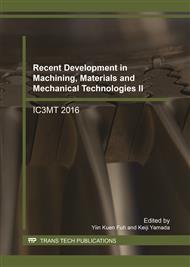p.211
p.217
p.223
p.229
p.234
p.241
p.246
p.251
p.257
Effects of Machining History on Tribological Properties of Bronze Containing Micro-Sized Sulfide
Abstract:
Bronze based alloys have come to be used as bearing materials, and require low frictional properties. The present study describes the effects of surface finish machining history on the on tribological properties of sulfide-containing bronze sintered onto a steel disc. The sulfide phase consisted of copper, iron and sulfur, and acted as a solid lubricant. The relative density of the specimen was 90 % and the microstructure showed that the micro-sized sulfide dispersed into the bronze matrix and was accompanied by pores. Various processes, including cutting, burnishing, polishing were, applied to finish the surface. It was found that the area fraction of the sulfide phase depended on the cutting conditions. A further increase in the area fraction was achieved using roller burnishing after the cutting. Tribological properties were evaluated using chromium alloy steel (SUJ2) as the mating surface under dry conditions. The results showed that the friction coefficient depended on the surface finishing process. Therefore, the machining history had an effect on the frictional properties of the sulfide-containing bronze. Optimal cutting conditions for the sulfide containing bronze are also discussed.
Info:
Periodical:
Pages:
246-250
Citation:
Online since:
August 2017
Authors:
Keywords:
Price:
Сopyright:
© 2017 Trans Tech Publications Ltd. All Rights Reserved
Share:
Citation:


